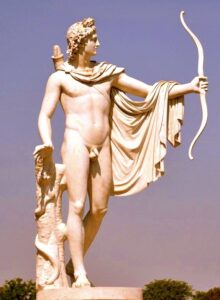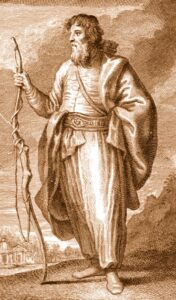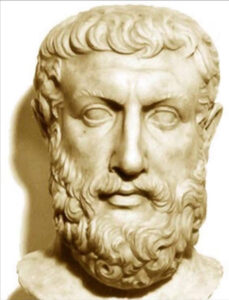Abaris the Avar Master
Master of Pythagoras
The Scythian-Hun enlightened masters of Hyperborea (Inner Asia) saw Apollo taking birth in human form on the shores of the Mediterranean Sea. Apollo was the deity, the buddha of inner radiance, that in Buddhism might correspond to Amitabha. This incarnation was Pythagoras. The masters of Inner Asia sent the enlightened master Abaris, who had realised within himself Apollo’s nature (enlightened nature) – the inner radiance of universal love, infinite compassion and omniscient wisdom – to seek out Pythagoras and give him the necessary transmissions and training so that he too could realise Apollo’s nature. Abaris fulfilled his mission and thus launched, together with his disciple, what we now call European civilisation.



The ‘pre-Socratic’ philosophers, the founding fathers of Western civilisation, Parmenides, Empedocles, Pythagoras and their ilk, were mystics and prophets who acted as a link in the ancient, hidden, primitive Western tradition. For them, science and philosophy came from the spiritual and were meant to lead back to the spiritual. Historically, their work has served as the starting point and inspiration for much of the hermetic, alchemical and even Islamic mystical tradition. Western civilisation is itself a product and heir of a sacred tradition.
Abaris, the wandering healer, miracle worker and prophet, arrived in Greece as a mysterious guest from the East, and eventually played a central role in the life of Pythagoras – and thus in the development of Western science, philosophy and culture. The wisdom of the West is directly linked to the Scythian non-dogmatic inner path tradition.
The homeland of Abaris, Hyperborea, coincides with the territory of present-day Inner Asia, which was inhabited by Scythians and Huns in Abaris’ time. Abaris himself, as many scholars have noted, bore the traits and paraphernalia of a shaman.
The meeting of Abaris and Pythagoras led to one of the most influential discoveries in history. This encounter was a crucial one for both men. The intimate relationship between Pythagoras and the inner-Asian ecstatic healer, miracle-working prophet and shaman sheds light on many elements of the Pythagorean tradition which, as some scholars have noted earlier, are clearly shamanistic.
It would be difficult to overestimate the impact of Pythagoras on Western civilisation. Among the pre-Socratic thinkers who are considered heroes of Western civilisation, Pythagoras is of outstanding importance. He is rightly regarded as a creator of culture, a shaper of civilisation, from whom the very word ‘philosophy’ derives. Pythagoras and the mystical Eastern tradition that inspired him so much reaches to the roots of the Western world. This subtle yet powerful influence, this sacred transmission from East to West, is part of the mystical process in which the seeds of new cultures are scattered and take root. Centuries later, the Pythagorean tradition spread to Egypt and the Middle East, and eventually to the heart of the Persian Sufi tradition, and so the seeds of the new culture were scattered in ever more places.
The interweaving of East and West did not stop with Pythagoras and Abaris. Hyperborea was not only the home of Abaris, but also of Apollo. Moreover, Abaris was not the first Hyperborean to visit what was then Greece on a sacred mission. To this day, secret records of early Western historians have survived that the most sacred Greek sanctuaries were founded by the same strange Hyperborean visitors who, accompanied by Apollo, once brought back to the Greeks their most precious and important traditions.
Centuries later, when Pythagoras claimed to be the “Hyperborean Apollo”, and when the Hyperborean Abaris roamed Greece in an ecstatic state and was reported to carry Apollo within him, it was only a continuation of something much, much more ancient. The link between Pythagoras, Abaris and Apollo, and between Apollo, Hyperborea and Greece, takes us back to the misty antiquity of the West. If all this comes as a shock to us, it is because we know as little about the original nature of our Western culture as we know little about Apollo, the god whose light is a brilliance we no longer experience today.
The story of Abaris also draws our attention to another very important fact: it highlights the crucial role of the non-dogmatic spiritual tradition of Central and Inner Asia in the flowering of sacred wisdom. It is common in Europe to define our common sacred tradition in the light of the great cultures of Egypt, India, Persia, China, Greece, etc. The influence of ancient, nomadic cultures on the sacred tradition is often overlooked. The most extreme commentators even tend to see them as inferior to Western cultures. More recent research shows how much these often unrecognised cultures have given to humanity – quietly, humbly, often without recognition.
The Sufi masters were acutely aware of the paradoxical complexity of the Mongol invasion they were facing – a reality was unfolding before their eyes against which all their civilisational achievements had paled, a force that was crushing their old, fossilised illusions to make way for something entirely new. The Sufis recognised that Genghis Khan’s army was led and protected by the most powerful of the saints, the supreme spiritual power, the Prophet Khidr, the mysterious Green Man, who always ruled from behind the scenes in a way that the average human mind could not comprehend. As many Sufi thinkers have recognised: there is no escape from the barbarians, for they are the life behind all that we thought was life itself.
As long as the Scythian-Hun peoples remained true to their nomadic traditions, they were capable of performing the most wonderful alchemy. Far from the cultures we cherish, they went their own way, fertilising other cultures and sowing the seeds of new ones. The Scythian knights of King Arthur, the Huns of Atila, the Avars and the Hungarians of Árpád brought with them an all-embracing openness, a complete acceptance of religions based on non-dogmatic principles, which was almost the greatest threat to their enemies.
Our modern world is on the brink of collapse and we are wondering what the solution is. The stakes are high, our very survival depends on what we do. The modern age, with its technocracy, its reductionism and its renunciation of all that is sacred, cannot offer a real solution, because it is part of the problem. And those who wish to return to tradition are concerned about how to reconnect with the essence of the past without recreating it in its appearance. Pythagoras and Abaris answer this life-and-death question:
„There is only one way to take real steps forward – the way of the rapture that leads us out of ourselves. It has always been and always will be, for all of us. Here in the Western world we have this strange idea that culture just came into being on its own, which we then go on to create, shape and improve. But this is not at all true. Culture does not just happen. They are consciously created from another world with incredible compassion and determination.”
Sacred traditions create cultures and civilisations. Tradition is the living soil from which our culture springs. Pythagoras, Abaris and people like them found a way to transcend themselves and in doing so, they made holiness possible. And their enthusiasm created a new world.
Of the great waves of the non-dogmatic Eurasian inner path that brought spiritual renewal to Europe, Abaris was thus the first known bearer. Beside him there were other enlightened Scythian masters of the Greeks – Toxaris (the Tokhar), Anaxarchis (the Onogur?) and others; they were followed by the Greek Pyrrho, who studied in India, in the time of Alexander the Great; the third wave was brought by Jesus, who studied in India, Tibet and Central Asia; he was followed by the Scythian knights of the Alans: King Arthur and the Knights of the Round Table; then the Huns of Atilla, the Avars, the Hungarians of Árpád; then the Central Asian, Asia Minor, Greek and other masters of the Renaissance; in the 19th century, the work of Sándor Kőrösi Csoma and others; and today, the masters of Tibet, India, Japan, China, Southeast Asia and others.
